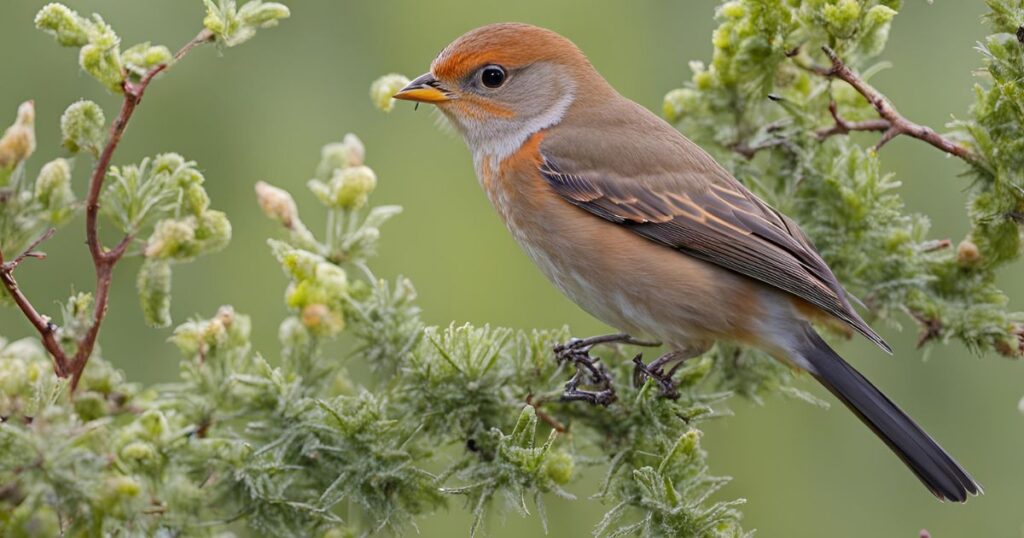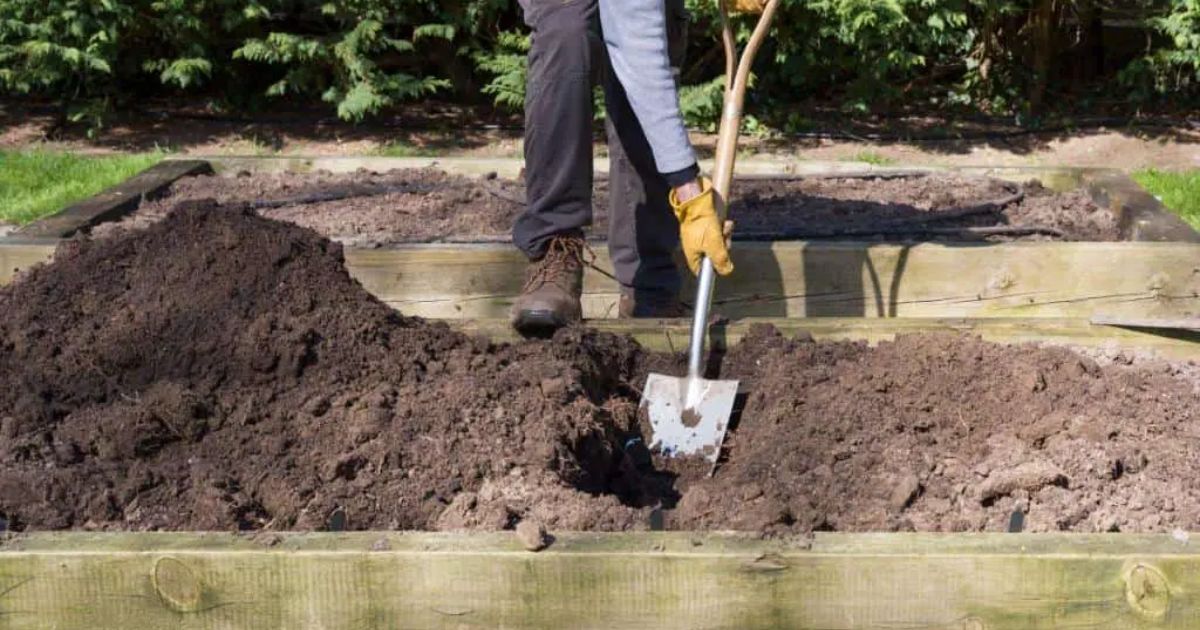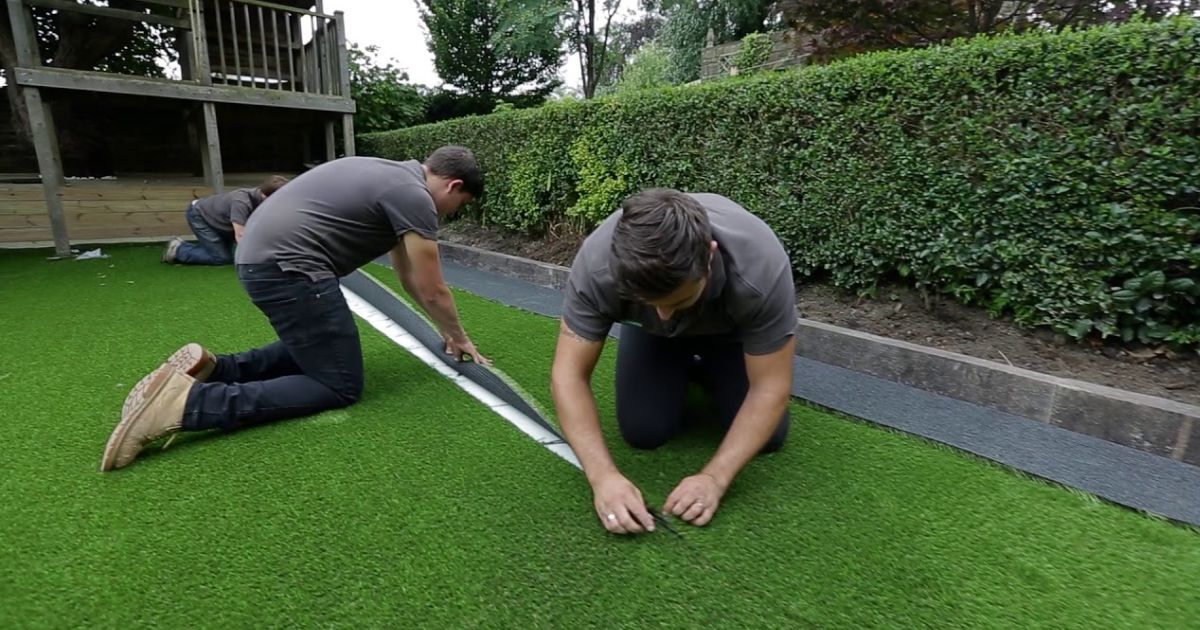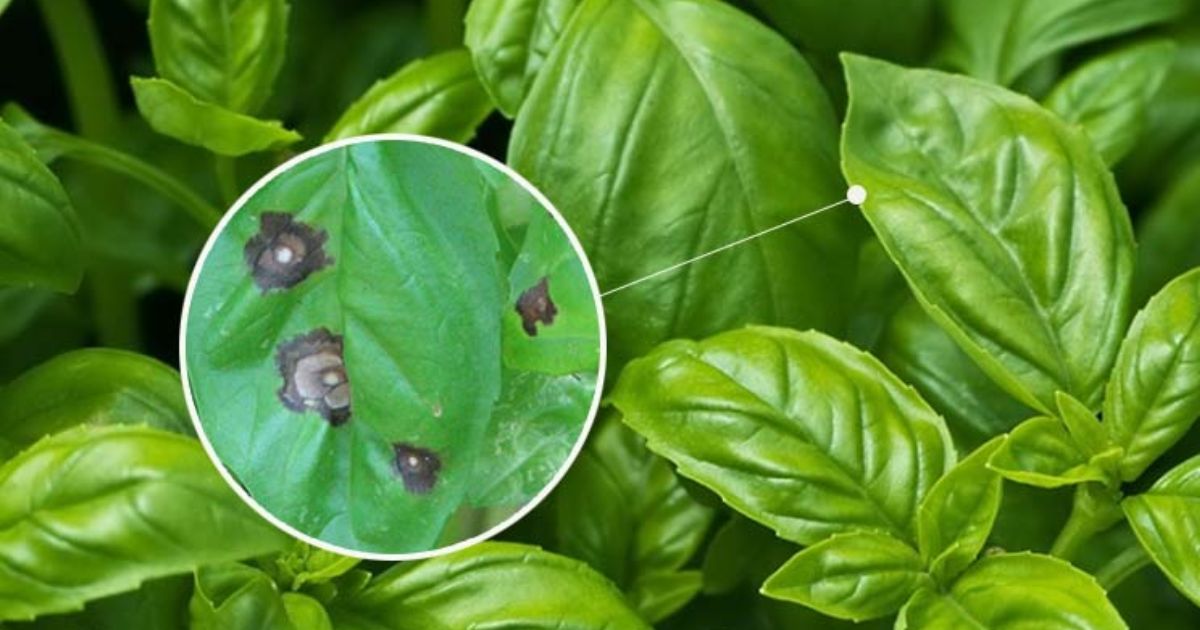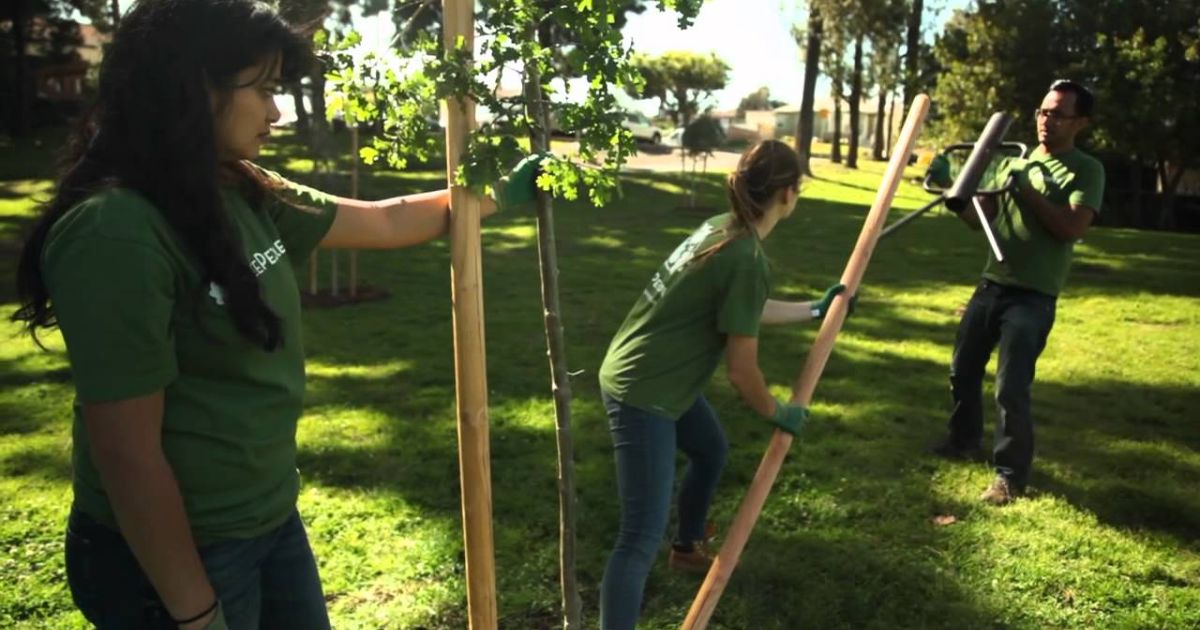If you’ve ever dreamt of transforming your garden into a vibrant haven filled with chirping birds, attracting common British garden birds is the perfect way to make that vision a reality. Whether you’re an avid birdwatcher or want to improve your outdoor space’s inherent attractiveness, creating an environment that appeals to local wildlife can be incredibly rewarding. By taking a few simple steps, you can encourage a variety of garden birds to visit, from the cheerful Robin to the charming Blue Tit.
So, how do you attract common British garden birds to your garden? The answer lies in providing the right combination of food, shelter, and water. With a little effort, your garden can become a sanctuary for these beautiful creatures, offering them a safe place to eat, rest, and nest. In this guide, we’ll explore practical tips and tricks for creating a bird-friendly garden that will attract a wide range of garden birds, ensuring your space is buzzing with life all year round.
The Benefits of Attracting British Garden Birds
Attracting British garden birds to your garden goes beyond the simple joy of birdwatching—it brings numerous benefits that positively impact the ecosystem, the beauty of your garden, and your overall connection with nature.
Biodiversity Support: Birds play an essential role in maintaining the balance of ecosystems. Many species contribute to natural pest control by feeding on insects, including aphids and caterpillars, that can damage plants. Some birds also help with pollination, As they consume nectar, they transport pollen from one blossom to another. Additionally, birds help disperse seeds, facilitating plant growth and contributing to the regeneration of native plants in your garden. By attracting birds, you support biodiversity and foster a healthy environment for other wildlife.
Enhancing Garden Beauty: The presence of birds adds dynamic beauty to your outdoor space. Their vibrant feathers, fascinating behaviors, and melodic songs create a lively atmosphere that transforms a dull garden into a thriving natural sanctuary. Observing birds as they fly from one tree to another or feeding at bird tables brings energy and interest to your garden throughout the year. Furthermore, birds are essential to creating a lively garden, changing with the seasons as different species visit or nest. From the vibrant colors of the Blue Tit to the gentle song of the Blackbird, their presence truly elevates the aesthetic value of your garden.
Educational Value: Attracting birds to your garden provides valuable learning opportunities for children and adults. It introduces the concept of birdwatching, an enjoyable and educational activity that helps develop an appreciation for wildlife and nature. Youngsters can study many bird species, their behaviors, and the importance of preserving natural habitats. For adults, birdwatching can foster a deeper connection to the natural world, encouraging sustainable gardening practices and a better understanding of local wildlife. Whether you’re tracking which species visit your garden or teaching the next generation about the birds’ role in nature, your garden becomes a living classroom that offers endless learning experiences.
Inviting British garden birds into your space enhances its beauty, contributes to a healthier ecosystem, and offers countless educational opportunities for everyone involved.
Common British Garden Birds to Attract
Several species are easy to spot and delight common British garden birds. Each bird brings something unique to your garden, from beautiful plumage to cheerful songs. Here’s a list of popular British garden birds that you can encourage to visit your outdoor space:
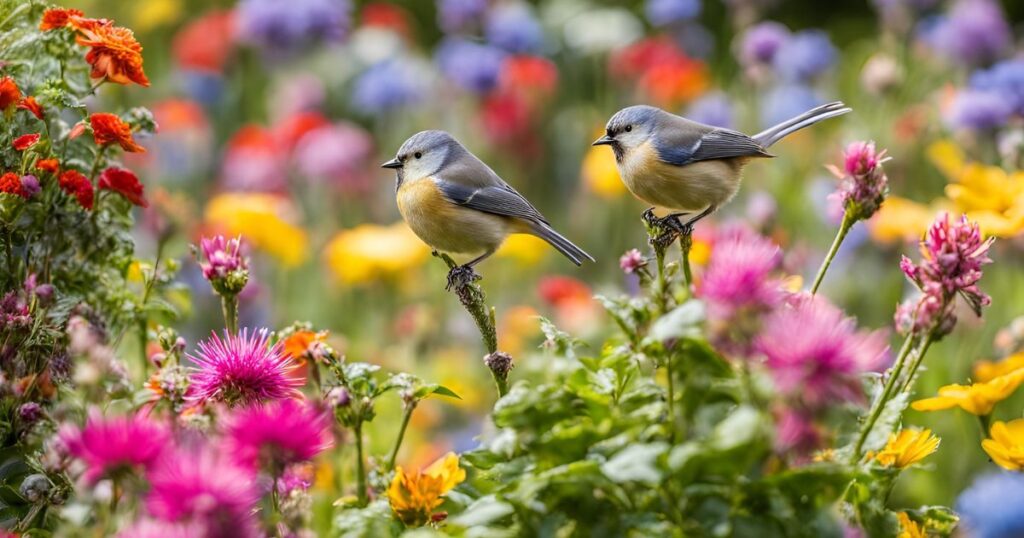
Blue Tit
The Blue Tit is one of the most recognizable British garden birds. With its bright blue cap and yellow underbelly, this small, acrobatic bird is a favorite among birdwatchers. Blue Tits are particularly fond of peanuts, sunflower seeds, and fat balls, making them easy to attract to feeders. These energetic little birds can often flit around gardens, feed on insects, and hang upside down from branches.
Robin
The Robin is among the most iconic uk small garden birds, often associated with winter and Christmas. Known for its bright red breast and curious, friendly nature, the Robin is a garden visitor you’ll likely encounter year-round. Robins are ground feeders, so providing mealworms or suet can attract them to your garden. They’re also known to be quite territorial, often singing their sweet song to establish their space.
House Sparrow
The House Sparrow is a common garden birds and easily recognizable bird, often hopping around gardens and urban spaces. Male sparrows have a distinctive grey crown and black bib, while females are more muted. They prefer seeds, particularly sunflower seeds, and are social creatures that often gather in groups. Sparrows will also appreciate small british garden birds shrubs or hedges where they can find shelter and nest.
Starling
Starlings are known for their glossy, iridescent feathers, which change color in the sunlight, creating a stunning display. These birds are highly social and often form large flocks, especially in the colder months. Starlings are natural foragers, feeding on insects and fruits, but they will also visit bird feeders, mainly if suet or mealworms are offered. Their chattering calls and remarkable group behavior make them fascinating to watch.
Blackbird
The Blackbird is another beloved British garden bird, known for its melodious song and striking black plumage. Males have a bright yellow beak, while females have a brownish shade. Blackbirds are ground feeders who enjoy mealworms, fruits, and berries. Their beautiful songs, often sung at dawn or dusk, add a soothing, musical touch to any garden, making them a favorite among bird enthusiasts.
Great Tit
Compared to the Blue Tit, the Great Tit is more prominent and is easily identified by its bold black and white markings. These birds are highly adaptable and are among the few species that thrive in urban and rural gardens. Great Tits enjoy a variety of foods, including peanuts, sunflower seeds, and fat balls, and are known for their acrobatic feeding skills. They have an easily recognizable “teacher, teacher” call.
By offering a diverse range of food, shelter, and water sources, you can encourage these popular small garden birds uk to visit your garden. Whether it’s the friendly Robin, the lively Blue Tit, or the social Starling, each bird adds its charm to your outdoor space, creating a vibrant and beautiful environment for you to enjoy year-round.
Essential Tips to Attract Common British Garden Birds
If you want to create a space that attracts a variety of common British garden birds, providing a mix of water, food, shelter, and nesting opportunities is essential. These elements make your garden more inviting for birds and help them thrive throughout the year. Below are some crucial tips for creating a bird-friendly environment to attract and sustain local wildlife.
Provide Food
Birds need a reliable food source to keep their energy up, especially during the colder months. Here are some of the most popular types of food that birds prefer:
- Sunflower Seeds: Tits are among the many bird species that love these seeds, Sparrows and Finches. Sunflower hearts, in particular, are a great choice as they don’t leave behind messy husks.
- Peanuts: Whole or crushed peanuts are a highly nutritious food for birds like Blue Tits, Great Tits, and Nuthatches. However, ensure the peanuts are unsalted and in a mesh bag to prevent choking.
- Suet: Suet is an essential winter food that provides high energy in the colder months. Suet cakes and balls are beautiful to Robins, Starlings, and woodpeckers. You can find suet with added seeds and dried fruits, which many birds love.
- Bird Seed Mixes: These can offer various seeds appealing to birds, like house sparrows, finches, and starlings. Choose a high-quality blend that includes millet, oats, and sunflower seeds.
In winter, high-fat foods such as suet and peanuts are crucial for birds, as they need extra energy to stay warm. During spring and summer, offer lighter foods such as seeds, fruits, and insects, as birds are often more active and require food for breeding and rearing their young. banana flower side effects
Offer Fresh Water
Clean water is essential for birds, not only for drinking but also for bathing. Birds need to keep their feathers in good condition, and a water source provides them a place to clean themselves. Here’s how to provide fresh water:
- Bird Baths: These are ideal for offering both drinking and bathing opportunities. A shallow bird bath with fresh water attracts species like Robins, Blackbirds, and Sparrows. Make sure to keep the water clean and topped up regularly.
- Shallow Dishes: Placing a shallow water dish on the ground or a raised platform can attract birds if you don’t have a bird bath. Ensure the dish is low enough for smaller birds to access quickly.
- Heated Water in Winter: Bird baths may freeze during the winter. You can invest in a heated bird bath or place a small, non-toxic heater in the water to keep it from freezing, giving birds a constant water source even in cold temperatures.
Create Shelter
Providing shelter in your garden is key to attracting and protecting birds. Native shrubs, trees, and bushes offer birds places to hide from predators and rest during harsh weather conditions. Here are a few tips for creating shelter:
- Plant Native Shrubs and Bushes: Native plants offer a natural shelter for birds, providing cover and hiding nesting places. Look for shrubs like Hawthorn, holly, and blackthorn, which produce berries that birds can eat.
- Tall Trees: Large, mature trees offer birds a place to roost and nest. Trees like oak, ash, and birch provide shelter and a source of food, such as seeds, berries, and insects.
- Evergreen Plants: Evergreens, like conifers, are valuable because they offer year-round bird shelter, even in winter when other foliage may be sparse. How to Use Coffee Grounds for Plants
Install Bird Feeders
Bird feeders are an excellent method of drawing various birds into your garden. Different types of feeders can help target specific species, ensuring you attract a diverse range of birds:
- Tube Feeders: These feeders are perfect for smaller birds like Finches and Tits, who enjoy seeds like sunflower hearts. Tube feeders also help protect food from larger, more aggressive birds.
- Platform Feeders: Ideal for larger birds like Starlings, Sparrows, and even pigeons, platform feeders allow birds to feed together in groups. They can hold various food types, such as seed mixes, suet, and fruit.
- Suet Feeders: Suet feeders, such as cages or mesh bags, are excellent for attracting birds like Woodpeckers, Starlings, and Robins, especially in winter when high-fat foods are necessary. They come in various shapes and are a great way to offer nutrient-rich suet.
Provide Nesting Sites
Consider offering nesting sites like bird boxes to attract birds to nest in your garden. Different species of birds prefer other types of nest boxes, so choosing the right one for the species you’re targeting is essential:
- Small Nest Boxes: Ideal for species like Blue Tits and Robins, small, well-designed boxes with a hole around 25mm in diameter will encourage them to nest.
- Larger Nest Boxes: To attract species like Starlings, use larger boxes with a hole diameter of about 40mm. Starlings are known to nest in tree cavities or even in the eaves of buildings, so providing the correct box will increase your chances.
- Open Nests for Robins: Robins prefer to nest in more open spaces, such as in dense shrubs or on the ground. Providing a sheltered spot with natural nesting material can entice them to establish themselves in your garden.
By combining these elements—food, water, shelter, and nesting sites—you can create an environment that will attract a wide range of uk small garden birds, making your garden a haven for local wildlife all year round. catfacing on tomatoes
The Best Plants for Attracting British Garden Birds
The types of plants you include can make a significant difference when creating a bird-friendly garden. Certain plants provide shelter and offer birds a natural food source. Proper vegetation can attract british garden birds identification while promoting biodiversity and common uk birds supporting local wildlife. Here’s a guide to the best plants for attracting birds and enhancing your garden’s ecosystem.
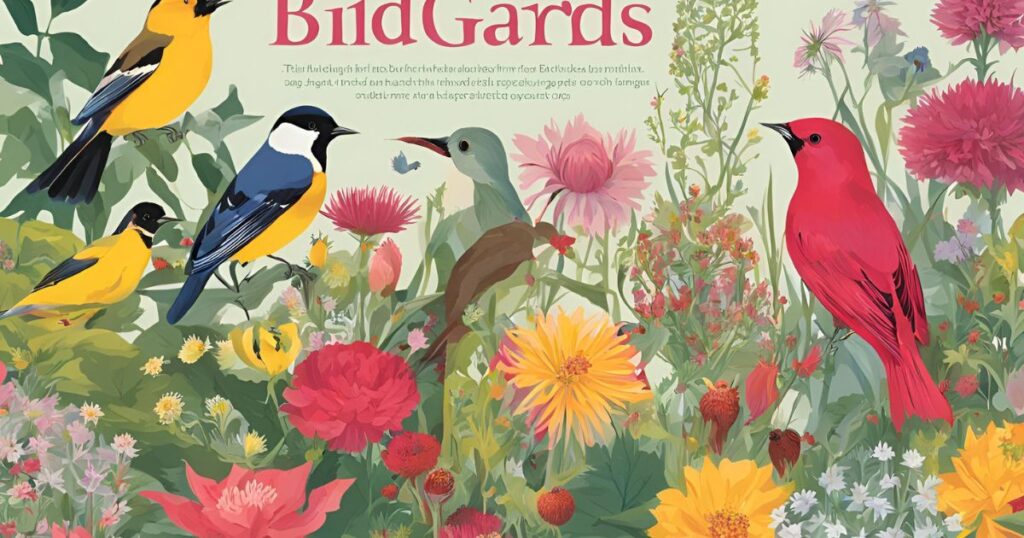
Berry-Bearing Shrubs
Berry-producing plants are a fantastic way to feed birds throughout the year. These shrubs offer essential food during the autumn and winter months when other sources of nutrition may be scarce. Some of the best berry-bearing plants for attracting birds include:
- Holly (Ilex aquifolium) is a classic British shrub with vivid red berries and beautiful, evergreen foliage. It provides year-round bird cover, and its berries are a crucial food source for species like Blackbirds, Thrushes, and Robins during winter.
- Rowan (Sorbus aucuparia): Mountain Ash is another name for it, the Rowan tree produces clusters of small red berries that attract various birds, including Thrushes, Starlings, and Woodpigeons. The tree’s delicate spring flowers and vibrant autumn berries offer both aesthetic appeal and food for wildlife.
- Elderberry (Sambucus nigra): Elderberry bushes are excellent for attracting a variety of birds. Their small white flowers bloom in spring, followed by clusters of dark berries loved by species like small birds, Starlings, and Bullfinches. Elder also provides dense cover for nesting birds.
Flowering Plants
Flowering plants not only brighten up your garden but can also attract birds by providing nectar and seeds. These plants are particularly beneficial during the spring and summer months when birds need to feed to raise their young:
- Lavender (Lavandula angustifolia): Lavender is fragrant and beautiful and attracts insects that birds feed on. Species like Tits and Sparrows are known to forage in lavender bushes for insects, making it a great addition to your garden.
- Foxglove (Digitalis purpurea): These tall, striking flowers attract pollinators, which in turn draw birds that consume insects, such as Tits and Warblers. The dense foliage of Foxglove also offers birds a place to hide from predators.
- Sunflower (Helianthus annuus): Sunflowers are not only visually appealing but also produce seeds that many birds, including Finches, Sparrows, and Tits, will flock to in late summer. Sunflowers also encourage pollinators like bees, creating a vibrant and dynamic ecosystem in your garden.
Native Plants That Support Local Birds
When selecting plants for your garden, it’s always best to opt for native species, as they provide food, shelter, and nesting opportunities suited explicitly to local wildlife. Additionally, native plants have a higher chance of thriving in the regional climate and support a healthy ecosystem. Some excellent native plants for attracting British birds include:
- Hawthorn (Crataegus monogyna): Known for its beautiful white spring blossoms and red berries in autumn, Hawthorn is a fantastic plant that attracts many small uk garden birds. Blackbirds, Sparrows, and Thrushes are particularly fond of the berries, and the dense foliage provides shelter and nesting sites.
- Blackthorn (Prunus spinosa): The Blackthorn bush, with its spiny branches and white flowers in spring, offers both food and shelter. Its sloes (blue-black berries) are popular with birds like Thrushes and Blackbirds, and its dense, thorny structure provides excellent cover for nesting and hiding.
- Wild Cherry (Prunus avium): The Wild Cherry tree offers both beauty and benefits to birds. Its blossoms in spring provide nectar for pollinators, while the cherries in late summer are a favorite of species like Starlings, Robins, and Jays.
Plants for Year-Round Cover
Providing year-round shelter is essential for birds, especially in colder months when they need protection from the elements and predators. Some plants offer evergreen cover, ensuring birds have a safe place to rest and hide throughout the seasons:
- Ivy (Hedera helix): Ivy is an excellent plant for year-round cover, offering dense foliage that shelters birds from the wind and rain. It’s also an excellent food source, with its berries ripening in the winter months and attracting species like Blackbirds, Woodpigeons, and Thrushes.
- Honeysuckle (Lonicera periclymenum): Honeysuckle is a climbing plant that provides a perfect mix of food, shelter, and nesting opportunities. In spring, its fragrant flowers attract pollinators, while its berries offer food in late summer and autumn for birds like Sparrows, Thrushes, and Blackbirds. Its dense, twisting vines also provide excellent cover for birds to hide and nest in.
- Conifers (Various species): Evergreen trees like Scots Pine (Pinus sylvestris) or Yew (Taxus baccata) provide all-year-round shelter and food. Their dense foliage shields birds from harsh weather and predators. They also attract insects and produce seeds that many species, including Woodpigeons and Tits, will feed on.
By planting these berry-bearing shrubs, native plants, and evergreen species, you can create a thriving habitat for various British garden birds. These plants provide birds with food and shelter and promote sustainable gardening practices by encouraging biodiversity and supporting the local ecosystem. With the proper vegetation, your garden can become a bird sanctuary, helping them thrive throughout the year.
Seasonal Care for Attracting Birds
Attracting birds to your garden isn’t just about setting up feeders or planting the proper vegetation—it’s also about providing the appropriate support throughout the changing seasons. Different times of the year bring unique challenges and opportunities for birds, so adjusting your garden care will ensure that birds find everything they need to thrive year-round. Here’s a breakdown of how to care for your garden to attract birds each season.
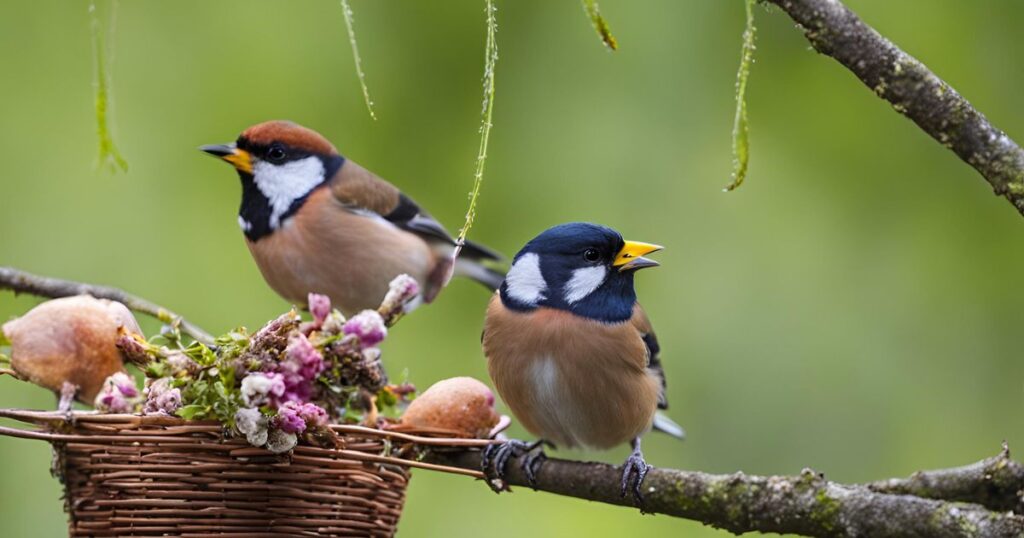
Winter: A time for Extra Food and Water
During the colder months, food sources for birds can become scarce, and the harsh weather conditions make it more difficult for them to find sustenance. Winter can be challenging for birds, but you can help them through this challenging season by providing extra food and water.
- Food: Focus on offering high-fat foods like suet, peanuts, sunflower seeds, and mixed bird seeds. These foods give birds the energy to stay warm and healthy in the cold. High-fat options are significant in winter, as birds burn many calories to maintain body heat.
- Water: Just as important as food, clean water is essential for birds in winter. A small dish filled with fresh water or a bird bath provides a place for birds to drink and bathe, even when frozen water sources are unavailable. To prevent the water from freezing, you can place a birdbath heater in the water, ensuring that birds always have access to hydration.
Maintaining a consistent supply of food and fresh water can help birds through the brutal winter months and attract a wide range of species to your garden.
Spring: Preparing for Nesting and Fresh Growth
As the days get longer and warmer, birds are busy preparing for their breeding season. Spring is the perfect time to ensure your garden is ready to support birds as they build nests and raise their young.
- Nesting Sites: Provide safe and quiet spaces for birds to nest. Install birdhouses or nesting boxes appropriate for the species you’re trying to attract. Make sure they are securely placed in sheltered spots, away from predators. You can also allow areas of your garden to grow a little wilder, offering natural nesting material like grass, twigs, and moss.
- Fresh Plants: Spring is an ideal time to plant new vegetation for food, shelter, and nesting opportunities. Choose native plants that attract insects and produce berries. Plants like lavender, holly, and Hawthorn will provide beauty and nourishment, creating a perfect environment for birds to raise their chicks.
Preparing your garden with these considerations in spring will create an ideal space for birds to lay eggs and care for their young.
Summer: Consistent Food and Water Supply for Busy Parents
During summer, birds are busy feeding their growing chicks and need a consistent and reliable food and water supply. This is particularly crucial as the temperature rises and insects, a key food source, become more abundant.
- Food: Continue to provide a varied diet with a mix of seeds, suet, and fresh fruit like apples or berries. Birds will need more food during the summer to meet the energy demands of raising their chicks. Consider adding a seed mix rich in sunflower seeds, millet, and oats, which many bird species love.
- Water: Just as in winter, clean water is essential during the summer heat. Birds need access to fresh drinking water, and your landscape can greatly benefit from the addition of a birdbath. To keep the water cool and fresh, clean your birdbath regularly and ensure there is no stagnant water where insects can breed.
By maintaining food and water supplies throughout summer, you’ll help most common british birds nurture their young while ensuring their strength and health.
Autumn: Preparing for the Cold Months Ahead
As autumn arrives, birds prepare for the colder months, gathering food and finding shelter. It’s essential to help them prepare for winter by ensuring food sources are abundant and providing plenty of cover.
- Food: Autumn is the time when birds start to stock up for winter. Increase the amount of food you provide, particularly energy-dense options such as suet, sunflower seeds, and peanuts. You can also plant berry-bearing shrubs that ripen in late autumn, offering a natural food source.
- Shelter: Autumn is also a good time to check on your birdhouses and nesting boxes to ensure they’re in good condition. As temperatures drop, birds may use these for shelter. Adding additional cover, such as evergreen shrubs or climbing plants like ivy, shelters birds from the wind and predators.
- Seed Collection: Allow seed-bearing plants like sunflowers or wildflowers to go to seed in the autumn. This will give birds a natural food source as they prepare for the winter months. You can also add autumn-appropriate plants, like rowan or holly, to give birds berries to feed on during the colder months.
Focusing on these tasks during the autumn will ensure that your garden remains a vital resource for birds preparing for winter.
Adjusting your bird-friendly practices according to the seasons can create a welcoming environment for birds year-round. Whether providing extra food during the harsh winter months, offering shelter and nesting opportunities in spring, or ensuring a steady food and water supply during summer, your garden can be a haven for birds no matter the time of year. With some seasonal care, you’ll help sustain your garden’s healthy, diverse bird population.
Additional Tips for Attracting British Garden Birds
In addition to the essential tips for creating a bird-friendly garden, several other practices can enhance your garden’s appeal to British garden birds. By being mindful of these extra steps, you can ensure your garden is a safe, welcoming space for birds to thrive.
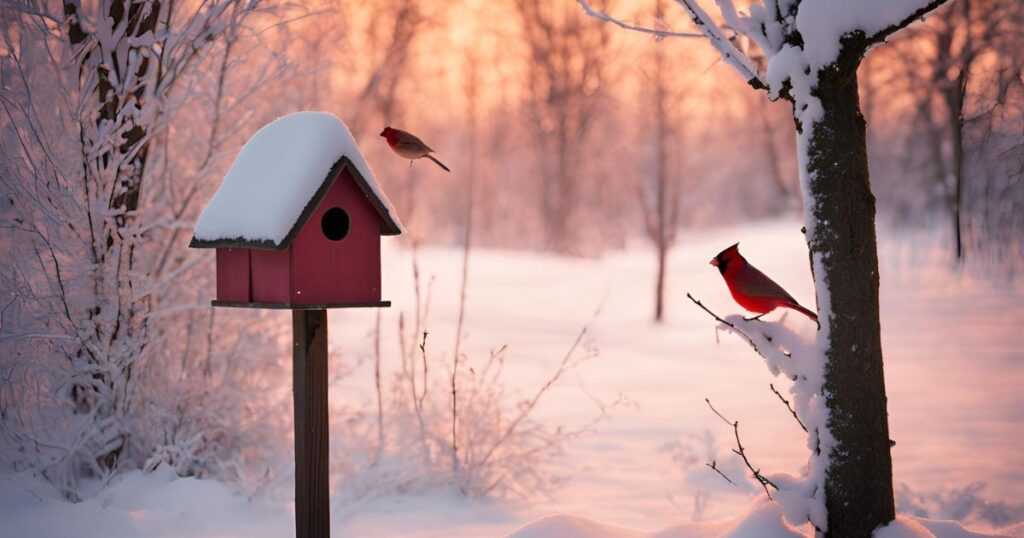
Avoid Pesticides: Protecting Birds from Harmful Chemicals
Pesticides and chemical treatments in the garden may seem like an effective way to manage pests, but they can harm birds. Many common garden chemicals are toxic to birds and can disrupt their feeding and nesting habits. When birds consume insects or seeds exposed to pesticides, they can ingest harmful substances that affect their health and reproductive success.
Keep your yard free of harmful pesticides, which attract most common british birds and create a safe environment for them. Instead, consider utilizing natural substitutes like neem oil and garlic sprays or introducing beneficial insects that help manage pests. These organic options are safer for birds and the broader ecosystem, helping maintain your garden’s health and balance. how to prevent bananas from splitting
Offer Birdhouses: Providing Safe Nesting Spaces
Providing birdhouses is an excellent way to give a secure area where birds can construct their nests and rear their young. Birdhouses offer shelter from predators and harsh weather, ensuring birds of garden have a safe place to rest and breed. However, it’s essential to place birdhouses correctly for them to be effective.
- Location: Choose a quiet, sheltered spot away from human activity and potential predators like cats. The ideal location is often in a tree or on a fence post, around 5-10 feet off the ground.
- Orientation: Position the entrance hole away from prevailing winds and rain to protect the birds from the elements.
- Size and Style: Different bird species require different types of birdhouses, so ensure that the box you offer is suited to the birds you want to attract. For example, blue tits prefer smaller boxes with a 25mm entrance hole, while robins need a more open, The No-Brainer Guide to Starting Seeds Indoors larger space.
By offering a well-placed and properly designed birdhouse, you can provide birds with a safe space to nest, fostering a more sustainable and bird-friendly garden.
Provide Nesting Materials: Helping Birds Build Their Homes
Birds use a variety of resources to build their nests, and you can help by providing natural nesting materials in your garden. Twigs, grass, moss, and leaves are the building blocks of a bird’s nest, and offering these items can help birds save time and effort gathering supplies.
You can provide nesting materials in several ways:
- Create a Nesting Pile: Leave small piles of twigs, straw, and grass clippings in the quiet corners of your garden.
- Provide Natural Filler: Set out natural materials such as pine needles, feathers, or small animal hair (e.g., from pets that shed). These materials can be left out in small containers or mesh bags, allowing birds to pick their needs.
- Planting Native Plants: Native shrubs and trees provide natural nesting materials like leaves, bark, and berries, giving birds a ready supply of resources.
By providing nesting materials, you help birds build safe, cozy homes for their families.
Keep Cats Indoors: Protecting Birds from Predators
One of the most significant threats to garden birds is predation by domestic cats. While many cats are beloved pets, they can pose a serious risk to bird populations. Cats are skilled hunters and often hunt birds, especially small species like sparrows and robins, putting pressure on local bird populations.
Keeping your cats indoors is essential to protect your garden birds, particularly during the breeding season when birds are nesting and vulnerable. How to Protect Trees If you must let your cat outdoors, consider using a leash or harness or providing a “catio” (a cat patio) where they can safely enjoy the outdoors without harming wildlife.
Keeping cats indoors reduces the risk of bird predation and gives your feathered visitors a safe, peaceful space to thrive in your garden.
By following these additional practices, you can create an even more bird-friendly garden that supports local wildlife. Avoiding harmful pesticides, offering birdhouses and nesting materials, common garden birds UK and ensuring birds’ safety by keeping pets indoors all help create a more sustainable and healthy environment for your garden birds. These thoughtful actions will help you attract a wide range of bird species and ensure they have everything they need to thrive and breed in your garden.
Conclusion
Attracting common British garden birds to your garden is a fruitful undertaking with several advantages, from enhancing biodiversity to providing a lively and educational environment. Creating a bird-friendly habitat with the right food, water, shelter, and plants makes your garden an inviting haven for various species. Whether providing fresh water, planting berry-bearing shrubs, or offering nesting sites, each action contributes to the well-being of the birds visiting your garden.
As you implement these tips and practices, you’ll enjoy the beauty and charm of the birds in your garden, which are essential for providing local wildlife. So, take the time to nurture your outdoor area and observe how it develops into a flourishing ecosystem that attracts a delightful and diverse range of British garden birds. You can create a garden that you and the birds will love with patience and care.
FAQ
1. What food should I provide for British garden birds?
To attract common British garden birds, provide a range of foods, including peanuts and sunflower seeds, suet, and birdseed mixes. Different species have different preferences, so providing a selection will encourage a broader range of birds to visit. During winter, high-fat foods like suet are beneficial to keep birds nourished in colder weather.
2. How can I provide water for birds in my garden?
For drinking and bathing, birds require clean water. You can place a bird bath or shallow dish in a quiet part of your garden, ensuring the water is regularly refreshed. Consider placing a heated bird bath in winter to ensure the water doesn’t freeze.
3. What are the best plants to attract birds?
Native plants are the most beneficial for attracting birds. Berry-bearing shrubs like holly and rowan provide food while flowering plants such as lavender attract insects, which birds can feed on. Plants like ivy and honeysuckle also provide year-round cover, giving birds shelter and a place to nest.
4. How can I create shelter for birds in my garden?
To create shelter, plant native shrubs, bushes, and trees that offer nesting sites and cover from predators. The dense foliage of these plants will provide a safe retreat for birds, helping them to hide from dangers like cats and larger predators.

